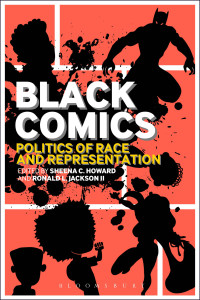All Eyes On Eisner Winner Dr. Sheena Howard

As a student working on her dissertation and finding little information regarding the contributions of African Americans in the field of comics and comics strips, Dr. Sheena Howard found the spark of inspiration for what would eventually serve as the basis for the book Black Comics: Politics of Race and Representation (Bloomsbury Publishing). A poignant look at the contributions and history of some of the sequential arts industries little known architects, this book has gone on to enlighten the comics making community and general public at large. Recently, Dr. Howard’s efforts and work received the highest recognition that can be afforded by the industry with her and her co editor Ronald L. Jackson II being awarded the Eisner Award for Best Scholarly/Academic work. This event is significant in that Dr. Howard is also the first African American Woman to ever receive the award. Revealing our shared history tells us who we are and inspires us as to what we might become and Dr. Howard looks to be one of the way finders who helps us catch a vision for what lies ahead. Taking time out of a very busy schedule, Dr. Howard was gracious enough to share a bit about her history with comics, the role of the medium within the African American community, and more.
Mark Turner: Admittedly, you weren’t a fan of comics before you began work on Black Comics: Politics of Race and Representation. Would you say that has changed since doing your research and finding how vast and varied the industry can be in terms of storytelling? Any titles that you currently find yourself following?
Dr. Sheena Howard: Absolutely! Since embarking on the publication of this book and traveling to several comic conventions on the East coast over the last year and a half I have met some amazing people. My interest in comics has increased tremendously. Though my area of expertise is the politics of race and representation as it relates to comic strips, I find myself critically analyzing various forms of comics. I really enjoyed Captain America: The Winter Soldier, particularly I appreciated the diversity and inclusion of Anthony Mackie’s character, Falcon. Far too often, media is focused on increasing diversity but it falls short of inclusion, meaning minority characters are seen but often times they are poorly written, underutilized and merely sidekicks or afterthoughts. Captain America: The Winter Soldier did a fabulous job of including The Falcon as a staple within the story and as a character that was essential to saving the world.
I am currently following, Watson and Holmes (New Paradigm Studios), looking forward to the Captain America comic book series dropping in November (Marvel Comics) and Black Jesus by Aaron McGruder (creator of The Boondocks) which will be airing on Adult Swin.
MT: In terms of your research and what you have learned in creating your book, What role do you see comic books playing in the African American community?
DSH: I believe comic’s books have always been and are a great form of political communication in which readers can learn a great deal from comics that critique the current social and political landscape. This is why I loved “The Boondocks” comics strip so much – there was so much to learn from the issues the strip dealt with, along the lines of race-relations, politics, combating racial stereotypes and more. I think comics, just like other mediums that are considered popular culture (at this point with the comics movies are popular culture) tell readers a great deal about the broader America cultural dynamic. Therefore, in critically analyzing this medium you learn that art reflects life and life reflects art. For example, I examined Black masculinity in The Boondocks comic strip and learned a great deal about male-female dynamics in the Black community and the historical underpinnings of Black hyper-masculinity as it relates to cowboy culture – the idea of being strong, emotionless and stoic. I think as a critical media scholar, my work helps to illuminate the intellectual value of comics.
MT: What made you decide to put together Black Comics: Politics of Race and Representation? What has the need for such a work revealed to you in regards to the current state of the industry? Do you notice any trends (made visible by your research) in terms of representation, participation and renaissance for communities of color?
DSH: I wrote Black Comics: Politics of Race and Representation because as I was writing my dissertation at Howard University on The Boondocks comic strip I became increasingly frustrated with the myriad of books on comics history that did not mention one single Black artist. I decided that this void needed to be filled – there is still a long way to go but this book is a start to at least introducing readers to a systematic historical timeline of Black comic strip cartoonists and publications.
I think the state of comics today is focused on adding diverse characters. For example, Thor as a female and Captain American as The Falcon; I hope this concerted effort to diversify continues to result in inclusion of the characters as essential fixtures in the plot. Inclusion means developing minority characters, hiring the best writers to add substance to these characters, using minorities and women to tell their own stories and developing the female and minority characters that are already created, such as Storm, The Falcon, Wonder Woman, etc.
One of the trends in the comics industry has been the cultural gate keeping of the medium and this is across the board but very visible on the funny pages. Editors of mainstream publishing houses and newspapers still tend to be White and male, so these are the people with the power to make the decision whether they will or will not publish your work and who they will make your work visible to. For minorities writing minority characters this dynamic makes it all the more difficult to get published. It is even more difficult as there is a trend of limiting the number of minority characters that can be spotlighted. For example, Barbara Brandon, the first Black female to be nationally syndicated on the funny pages told me that as long as she was writing her strip “Where I’m Coming From”, she knew that the industry would not let anymore Black women or comic strips about Black women through the gates; and they didn’t. This still happens today.
MT: Paralleling the experience of Black comic creators that you learned about through your research, what lessons do you feel that the LBGT community, women and communities of color creators can learn?
DSH: Comics were used as a form of social and political critique previous to the civil rights movement and during the civil rights movement. I think comics are still a viable form of protest rhetoric that minorities can utilize in speaking out against the status quo. For example, around the 1930’s the comic strips “Luther, Sunnyboy Sam” by Wilbert Holloway and “Bungleton Green” by Jay Jackson among others critiqued the reality of social and economic disparity within society and also, created multi-layered characters that challenged stereotypical representations of Blacks during that time period.
MT: What aspect of researching this book did you enjoy the most? Which story while researching the history of Black comics creators would you say you found the most striking/moving?
DSH: I enjoyed working with the contributors the most and learning other aspects of comics that I was not familiar with. I got to meet John Jennings, a world renowned artist; he designed the cover of the book. I was able to have an in depth discussion with Barbara Brandon, the first Black female comic strip artist to ever be nationally syndicated with her strip “Where I’m Coming From”. I learned so much from my phone conversations with her. There are countless others that contributed to the book and working with each and every one of them was the highlight for me. I found Barbara Brandon’s story most striking. She talked about being in boardrooms with editors who were mostly White, males and her experiences as a Black female cartoonist. These stories stood out to me because Barbara took the time to speak with me and because she gave insight into the cultural gate keeping of the comics industry.
MT: What does the winning of the Eisner mean to you? What kind of message do you think it sends the comics creating industry? Ultimately, what kind of impact do you think your book can and will have on the industry as a whole?
DSH: It means a great deal to me. For my work, which started out as a dissertation to cross over to the popular culture realm, it is a huge achievement for me as an academic. I think it does offer comic creators a sense of inclusion, especially for Black cartoonists. There are so many minority writers and artists that are looked over within the comics industry this book highlights a few of those artists. This book says ‘hey, it is time to include us. We are here and have been here’. I think this book and the winning of the Eisner will show people that all types of people are interested in comics and all types of people consume comics. I also hope it sends a message that no matter what age you are, you can indulge in comics. Sometimes the medium can be overwhelming if you are tapping into the industry as a fan later in life, but I think my win makes a statement that you can be a fan at any point in your life. I did not start seriously reading comic strips until my early 20’s.
MT: Where do you go from here? Has the sequential arts industry impacted you enough to pursue other endeavors within its confines?
DSH: Yes. I am currently working on future publications within the arena of comics. I want to pursue comics as protest rhetoric going forward – I should be starting research in that area soon. I have some other ideas as well but I don’t want to give too much away. You can expect more from me very, very soon. My areas of expertise are the politics of representation, sexual identity negotiation and media analysis, so I will continue to intersect those interests going forward. I have a book called Black Queer Identity Matrix, which explores the intricacies of Black, female sexuality and the politics of race, gender and sexual orientation. I also have a book coming out this September, called Critical Articulations of Race, Gender and Sexual Orientation.
MT: A lazy Sunday morning with the funny papers and a good cup of coffee, or a roaring fire on a winter’s night with a great graphic novel?
DSH: A lazy Sunday morning with the funny papers and a good cup of coffee; I love the political content found in so many comic strips, graphic novels are awesome but my preference will always be a great comic strip. And, downtime on a Sunday morning … PRICELESS!
Black Comics: Politics of Race and Representation is available in book stores now. To stay up to date with Dr. Howards latest efforts follow her on:
Twitter: @drsheenahoward
Website: www. sheenachoward.com
Blog: sheenachoward.wordpress.com
Black Comics: Politics of Race and Representation is TM and © Sheena C. Howard, Ronald L. Jackson, and Contributors, 2014
This article is © 2014 Mark C. Turner. All rights reserved.


Leave a Reply